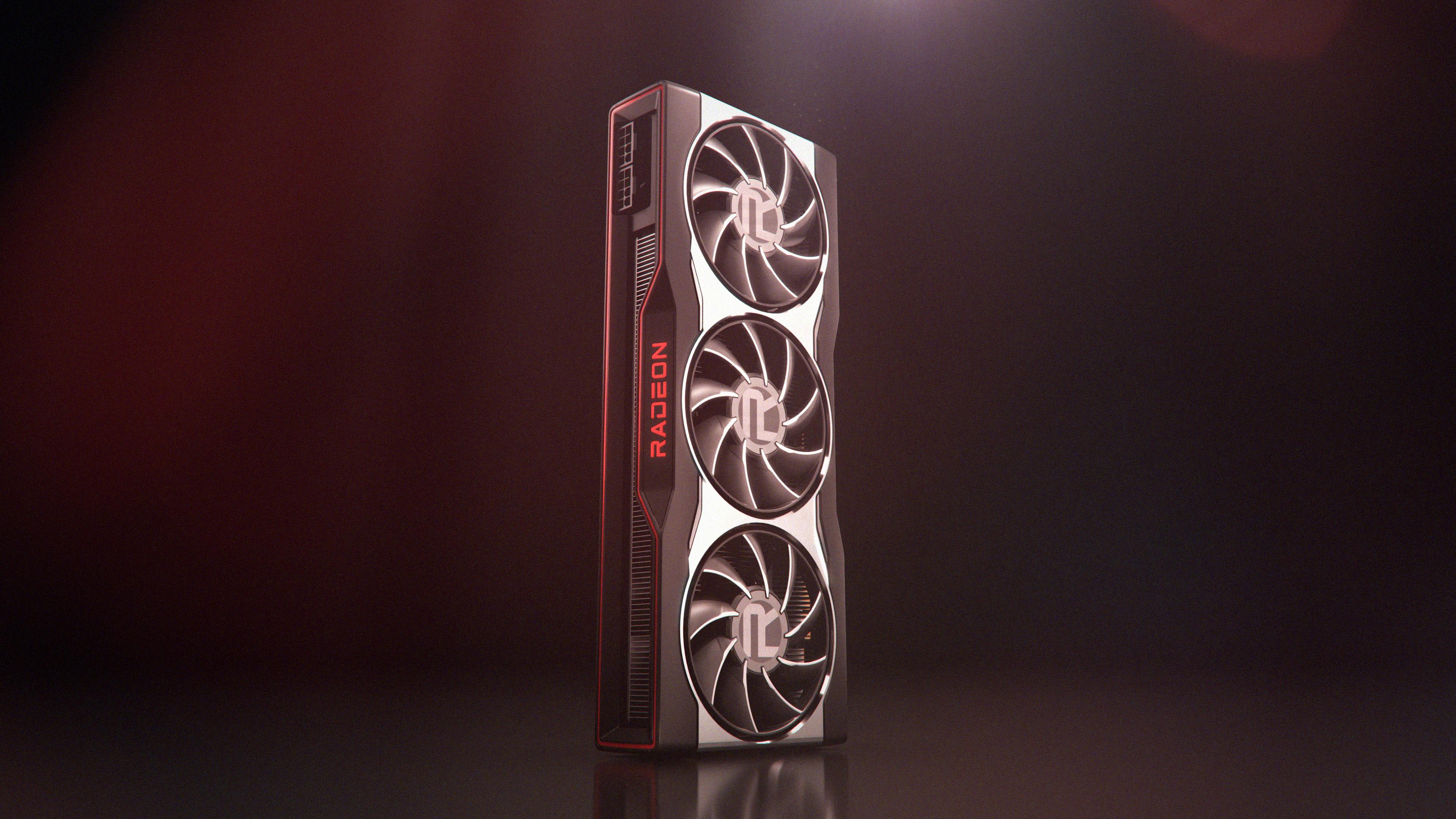Newly Uncovered AMD Radeon RX 6000 Specs Imply Significant Performance Uplift
Nvidia's GeForce RTX 30-series are the reigning champs on our best graphics cards standings, but they might not be there for long. A Redditor has discovered the potential specifications for the Radeon RX 6000 series in Apple's macOS Big Sur 11 beta, and they look promising.
The Redditor has a good track record with leaks, but we should still exercise caution with the specifications. For starters, Apple is fond of using AMD's Radeon Pro graphics cards in its products, so the specifications may be for those specific SKUs. On the other hand, the mainstream versions will likely arrive with higher clock speeds.
To start things off, Navi 21 (Sienna Cichlid) appears to have 80 Compute Units or 5,120 Stream Processors (SPs), assuming that each CU still carries 64 SPs on RDNA 2. According to the chip detective, there were mentions of two different dies: The Navi21A silicon showed a boost clock up to 2,050 MHz, while the Navi 21B silicon surfaced with a 2,200 MHz boost clock. The power limit varies from 220W to 238W.
There is more to a graphics card than just single-precision (FP32) performance, and that value alone doesn't dictate gaming performance. Just for comparison, the GeForce RTX 3080 offers a peak single-precision performance of 29.8 TFLOPs. In comparison, the single-precision performance for Navi 21 comes out to 22.5 TFLOPs. So far, the GeForce RTX 3080 seemingly has 32.4% higher single-precision performance than Navi 21. However, Navi 21 does pull a win over the GeForce RTX 3070, which is good for 20.4 TFLOPs.
AMD's RDNA 1 architecture delivered a 50% performance uplift over the prior Graphics Core Next (GCN) architecture that survived for so long and still going strong. The chipmaker has promised that we would see the same level of advancement with RDNA 2.
| Silicon | Codename | Compute Units | Stream Processors | Clock Speed (MHz) | Single-Precision Performance (TFLOPs) | Power Limit (W) |
|---|---|---|---|---|---|---|
| Navi 31 | ? | 80 | 5,120 | ? | ? | ? |
| Navi 21 | Sienna Cichlid | 80 | 5,120 | 2,050 - 2,200 | 21 - 22.5 | 200 - 238 |
| Navi 22 | Navy Flounder | 40 | 2,560 | 2,500 | 12.8 | 170 |
| Navi 10 (Radeon RX 5700 XT) | ? | 40 | 2,560 | 1,905 | 9.8 | 225 |
| Navi 23 | Dimgrey Cavefish | 32 | 2,408 | ? | ? | ? |
| Navi 14 ( Radeon RX 5500 XT) | ? | 22 | 1,408 | 1,845 | 5.2 | 130 |
Navi 22 (Navy Flounder) might arrive with 40 CUs, amounting to a total of 2,560 SPs. For the observant, that's the same number of CUs as found on Navi 10. It's safe to assume that Navi 22 is the direct successor to Navi 10. However, Navi 22 looks more impressive with its boost clock at 2,500 MHz within a 170W power limit.
The Radeon RX 5700 XT, based on Navi 10, comes equipped with 2,560 SPs with a boost clock of 1,905 MHz. The graphics card has a maximum single-precision performance of 9.8 TFLOPs. Navi 22 delivers 12.8 TFLOPs of FP32 shader performance, so we're looking at a 30.6% improvement. That's not to mention within a lower power requirement, remembering that the Radeon RX 5700 XT is rated for 225W.
Get Tom's Hardware's best news and in-depth reviews, straight to your inbox.
Navi 23 (Dimgrey Cavefish) would be the entry-level RDNA 2 silicon. The Navi 23 die may end up with 32 CUs (2,048 SPs). Unfortunately, the clock speeds and power limits for Navi 23 weren't hidden inside Apple's firmware.
Astoundingly, Apple already has an RDNA 3 graphics card in its macOS Big Sur 11 beta code. There was mention of a Navi 31 silicon, which we expect to see in the Radeon RX 7000 series. According to the Redditor's findings, Navi 31 has the same number of CUs as Navi 21. At the moment, it's unknown if Navi 31 will be a proper replacement or just a refresh for Navi 21, though.
AMD will announce its Radeon RX 6000 series on October 28. Nvidia's GeForce RTX 30-series has had a rocky launch. The graphics cards not only sparked a war between consumers and scalpers, but have also been plagued by serious stability issues, too. Let's hope AMD delights us with a smooth launch and ample availability.

Zhiye Liu is a news editor, memory reviewer, and SSD tester at Tom’s Hardware. Although he loves everything that’s hardware, he has a soft spot for CPUs, GPUs, and RAM.
-
King_V ReplyHowever, Navi 10 looks more impressive with its boost clock at 2,500 MHz within a 170W power limit.
I think that should say Navi 22 there.
That aside, I'm definitely intrigued, and, yes, I'll admit it, impatient to see what the October 28 announcement brings. -
Alvar "Miles" Udell In other words, AMD will only be able to compete with nVidia's mid range offering yet again, and will be significantly slower than the 3080, which means sky high GPU prices for at least another two years...Reply -
escksu ReplyAlvar Miles Udell said:In other words, AMD will only be able to compete with nVidia's mid range offering yet again, and will be significantly slower than the 3080, which means sky high GPU prices for at least another two years...
Been that way for a long long time already....i think we already read that big navi price will be 499.... So we can pretty much gauge the performance. -
catavalon21 ReplyAlvar Miles Udell said:In other words, AMD will only be able to compete with nVidia's mid range offering yet again, and will be significantly slower than the 3080, which means sky high GPU prices for at least another two years...
As a potential 3070 customer, this is fine by me. Agreed it won't help prices at the top any. I've never considered the NV x70 series "Mid range", or not lately anyway.
Of course, depending on what, if any, cards further down the stack they produce, could change terms for sure. -
catavalon21 At twice the 32 bit performance of the 5700XT, if valid, they've really upped their game generation over generationReply -
escksu EiReply
catavalon21 said:At twice the 32 bit performance of the 5700XT, if valid, they've really upped their game generation over generation
I believe it should. Big navi has double the number of stream processors (5120 vs 2560). And then AMD said it has up to 50% better performance/watt. 5700xt is between 2070 and 2080. So, big navi should be the same. And we have 499 launch price. -
javiindo I think 3070/3080 price is going to kick AMD plans. With 700$ for 3080 and 500$ for 3070, AMD should have a sub price of 500$ for their graphics top of the line to be competitive. Their only chance is that NVIDIA card for mid-range are not ready yet.Reply -
TCA_ChinChin Reply
Nah, I think that top of the line with 80 CUs should be able to compete with the 3080 just fine. The 80 CU card pretty nice at 500$, but I'm pretty sure AMD is going to market the 80CU model to compete with the 3080 anyways.javiindo said:I think 3070/3080 price is going to kick AMD plans. With 700$ for 3080 and 500$ for 3070, AMD should have a sub price of 500$ for their graphics top of the line to be competitive. Their only chance is that NVIDIA card for mid-range are not ready yet. -
Khahandran Reply
Where did you get that idea from? TFLOPs does not indicate gaming performance. For example, Vega 64 has more TFLOPS than 5700XT. 5700XT is still faster in all games.Alvar Miles Udell said:In other words, AMD will only be able to compete with nVidia's mid range offering yet again, and will be significantly slower than the 3080, which means sky high GPU prices for at least another two years...
You only need to look at the performance of the 5700XT with less CUs and lower clocks combined with the 50% more performance per W uplift from RDNA 1 to RDNA 2to get an idea that they're heading towards 3080 territory. -
cryoburner ReplyFor comparison, the GeForce RTX 3080 offers peak single-precision (FP32) performance of 29.8 TFLOPs. The single-precision performance for Navi 21 comes out to 22.5 TFLOPs. So far, the GeForce RTX 3080 seemingly has 32.4% higher single-precision performance than Navi 21. However, Navi 21 does pull a win over the GeForce RTX 3070, which is good for 20.4 TFLOPs.
All of this is meaningless when you consider that even the "36 Tflop" RTX 3090 performs more like a 20 Tflop Turing card in games. Nvidia made changes to their architecture with Ampere that affect FP32 compute performance resulting in those huge compute numbers, but those changes don't equate to equally-large gains in gaming performance. So, an RTX 3090 typically ends up only around 50% faster than a 13.5 Tflop 2080 Ti as far as 4K gaming performance is concerned.
Now of course, that doesn't mean the 80CU RDNA2 card will outperform a 3090, since we have no idea exactly how RDNA2's ratio of gaming to compute performance compares. As Ampere should make clear, more Tflops doesn't necessarily mean more gaming performance. At least Nvidia seems to feel it won't outperform the 3090 based on pricing, but their relatively competitive 3080 pricing indicates they feel it could be competitive with that card.
Since when is a $500+ graphics card "mid-range"? Just because niche "enthusiast" hardware becomes available at even higher price points doesn't mean that cards filling the "high-end" segment are suddenly "mid-range".Alvar Miles Udell said:In other words, AMD will only be able to compete with nVidia's mid range offering yet again, and will be significantly slower than the 3080, which means sky high GPU prices for at least another two years...
And as already stated, you can't directly compare gaming performance by Tflops alone, since different architectures can offer more or less gaming performance relative to compute performance, and that ratio changed substantially going from Turing to Ampere. If it were to remain mostly unchanged from first-generation RDNA to RDNA2 though, a 22.5 Tflop card could be right around the performance level of a 3080.
